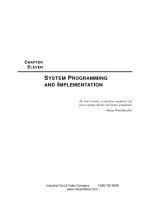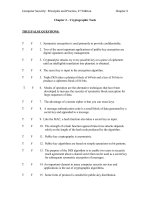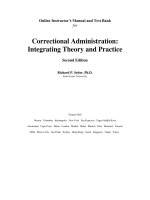Basic electronics theory and practice, 2nd edition
Bạn đang xem bản rút gọn của tài liệu. Xem và tải ngay bản đầy đủ của tài liệu tại đây (6.61 MB, 357 trang )
BASIC ELECTRONICS
Second Edition
LICENSE, DISCLAIMER
WARRANTY
OF
LIABILITY,
AND
LIMITED
By purchasing or using this book and disc (the “Work”), you agree that this license
grants permission to use the contents contained herein, but does not give you the right of
ownership to any of the textual content in the book or ownership to any of the
information or products contained in it. This license does not permit uploading of the
Work onto the Internet or on a network (of any kind) without the written consent of
the Publisher. Duplication or dissemination of any text, code, simulations, images, etc.
contained herein is limited to and subject to licensing terms for the respective products,
and permission must be obtained from the Publisher or the owner of the content, etc., in
order to reproduce or network any portion of the textual material (in any media) that is
contained in the Work.
MERCURY LEARNING AND INFORMATION (“MLI” or “the Publisher”) and anyone involved
in the creation , writing, or production of the companion disc, accompanying algorithms,
code, or computer programs (“the software”), and any accompanying Web site or
software of the Work, cannot and do not warrant the performance or results that might
be obtained by using the contents of the Work. The author, developers, and the Publisher
have used their best efforts to insure the accuracy and functionality of the textual
material and/or programs contained in this package; we, however, make no warranty of
any kind, express or implied, regarding the performance of these contents or programs.
The Work is sold “as is” without warranty (except for defective materials used in
manufacturing the book or due to faulty workmanship).
The author, developers, and the publisher of any accompanying content, and anyone
involved in the composition, production, and manufacturing of this work will not be
liable for damages of any kind arising out of the use of (or the inability to use) the
algorithms, source code, computer programs, or textual material contained in this
publication. This includes, but is not limited to, loss of revenue or profit, or other
incidental, physical, or consequential damages arising out of the use of this Work.
The sole remedy in the event of a claim of any kind is expressly limited to replacement
of the book and disc, and only at the discretion of the Publisher. The use of “implied
warranty” and certain “exclusions” vary from state to state, and might not apply to the
purchaser of this product.
Companion files may also be obtained by writing to the publisher at
BASIC ELECTRONICS
Theory and Practice
Second Edition
Sean Westcott
Jean Riescher Westcott
MERCURY LEARNING AND INFORMATION
Dulles, Virginia
Boston, Massachusetts
New Delhi
Copyright ©2018 by MERCURY LEARNING AND INFORMATION LLC. All rights reserved.
This publication, portions of it, or any accompanying software may not be reproduced in any way, stored in a
retrieval system of any type, or transmitted by any means, media, electronic display or mechanical display,
including, but not limited to, photocopy, recording, Internet postings, or scanning, without prior permission in
writing from the publisher.
Publisher: David Pallai
MERCURY LEARNING AND INFORMATION
22841 Quicksilver Drive
Dulles, VA 20166
www.merclearning.com
(800) 232-0223
S. Westcott and J. R. Westcott. Basic Electronics: Theory and Practice. Second Edition.
ISBN: 978-1-683920-33-5
The publisher recognizes and respects all marks used by companies, manufacturers, and developers as a means to
distinguish their products. All brand names and product names mentioned in this book are trademarks or service marks
of their respective companies. Any omission or misuse (of any kind) of service marks or trademarks, etc. is not an
attempt to infringe on the property of others.
Library of Congress Control Number: 2017934666
171819 3 2 1 This book is printed on acid-free paper.
Printed in the United States of America
Our titles are available for adoption, license, or bulk purchase by institutions, corporations, etc.
For additional information, please contact the Customer Service Dept. at (800)232-0223(toll free).
All of our titles are available in digital format at authorcloudware.com and other digital vendors. Companion disc files
for this title are available by contacting The sole obligation of MERCURY LEARNING
AND INFORMATION to the purchaser is to replace the disc, based on defective materials or faulty workmanship,
but not based on the operation or functionality of the product.
CONTENTS
Introduction
About the Authors
Part 1: The Fundamentals
Chapter 1: The Theory Behind Electricity
Atoms and Their Structure
Electrons
Valence Shell
Conductors, Insulators, and Semiconductors
Conductors
Insulators
Semiconductors
Electron Flow Versus Hole Flow
The Least You Need to Know
Chapter Review Questions
Chapter 2: How Electricity Works
Circuits
Electromotive Force or Voltage
Current
Resistance
Ohm’s Law
Power
Joule’s Law
Putting It All Together
The Least You Need to Know
Chapter Review Questions
Lab 2.1: Constructing a Simple Circuit
Chapter 3: Currents and Circuits
Direct Current
Alternating Current
The War of Currents
Waveforms
Sine Wave
Other Waveforms
Phase
Using Waves to Measure AC Voltage
Direct Current Waveforms
More About Circuits
Circuit Diagrams
Short Circuits
Fuses and Circuit Breakers
Serial and Parallel Circuits
Learning the Language of Electronics
The Least You Need to Know
Chapter Review Questions
Part 2: Your Workspace and Tools
Chapter 4: Tools of the Trade
Essential Hand Tools
Essential Instruments
Lab 4-1: Taking a DC Voltage Reading
Lab 4-2: Taking an AC Voltage Reading
Lab 4-3: Measuring Resistance
Lab 4-4: Measuring Current
Electronics Specialty Items
Essential Safety Items
The Least You Need to Know
Chapter Review Questions
Chapter 5: Shop Setup and Safety
A Clean, Well-Lit Workshop
Claim Your Space
Your Workbench
Adequate Power
Lighting
Ventilation
Storage
Safety Equipment
Good Work Habits Are Good Safety Habits
Come Ready to Work
Dress for the Job
Be Neat and Work Deliberately
Know How Electricity Flows
First Aid for Electrical Shock
The Least You Need to Know
Chapter Review Questions
Part 3: Electronic Components
Chapter 6: Switches
Switch Symbols
Mechanical Switches
Poles and Throws
Lab 6-1: SPDT Switch
Push-button Switches
Knife Switches
Bi-metal Switches
Mercury Switches
Other Mechanical Switches
DIP Switches
Electromagnetic Switches or Relays
The Least You Need to Know
Chapter Review Questions
Chapter 7: Resistors
The Mighty Resistor
Fixed-Value Resistors
Resistor Color Codes and Power Ratings
Reading the Code
Power Ratings
Surface Mount Resistors
Single in Line Resistors
Variable Resistors
Kirchhoff’s Laws
Calculating Resistance
Lab 7-1: Using Ohm’s & Kirchhoff’s Laws to Determine the Proper Resistor
Resistors in Series Circuits
Lab 7-2: Resistors in a Series Circuit
Resistors in Parallel Circuits
Lab 7-3: Resistors in a Parallel Circuit
Voltage Division Circuits
Lab 7-4: Voltage Division Using Fixed Value Resistors
Lab 7-5: Voltage Division Using a Variable Resistor
The Least You Need to Know
Chapter Review Questions
Chapter 8: Capacitors
How a Capacitor Works
Farads
Relative Permittivity
Capacitor Ratings
Nominal Value and Tolerance
Temperature Coefficients
Breakdown Voltage or DC Working Voltage
Polarized Capacitor Types
Electrolytic Capacitors
Tantalum Capacitors
Non-polarized Capacitor Types
Variable Capacitors
Capacitors in a Circuit
Transient Time of Capacitors in a DC RC Circuit
Lab 8-1: Charging Capacitance
The Least You Need to Know
Chapter Review Questions
Chapter 9: Diodes
How Diodes Work
Types of Semiconductor Diodes
Common Silicon Diodes
Zener Diodes
Schottky Diodes
Power Rectifiers
Light-Emitting Diodes (LEDs)
Photodiodes
Handling Diodes
The Least You Need to Know
Chapter Review Questions
Chapter 10: Transistors
Bipolar Junction Transistors (BJTs)
How Amplifiers Work
BJTs Under Varying Voltages
Gain
Darlington Pairs
Field Effect Transistors
Lab 10.1: Using a Transistor to Amplify Current
The Least You Need to Know
Chapter Review Questions
Chapter 11: Power Sources and Power Supplies
Batteries
How Batteries Produce Energy
Primary vs. Secondary Batteries
Voltages in Batteries
Lab 11-1: Making a Potato Battery
Batteries in Series and in Parallel
Amp-hours
AC-to-DC Power Supplies
Transformers
Variable DC Power Supplies
Uninterruptible Power Supplies
Switched-Mode Power Supplies
The Least You Need to Know
Chapter Review Questions
Part 4: Getting to Work
Chapter 12: Soldering
Solder
Lead-free Solder
Flux
Soldering Iron and Tips
Heat Sink
Circuit Boards
Printed Circuit Boards
Prepping for Soldering
Place the Items on the Board
Prepare Your Soldering Iron
Soldering Technique
Desoldering
The Least You Need to Know
Chapter Review Questions
Chapter 13: Constructing a Power Supply
Power Supply Kit and Construction
Safety First
Powering On
Getting Acquainted with Your Power Supply
Creating a Positive DC Wave
Seeing Caps and Voltage Regulators in Action
Using Your Variable DC Power Supply
The Least You Need to Know
Chapter Review Questions
Part 5: Going Digital
Chapter 14: Digital Theory
The Idea Behind Digital Concepts
Analog vs. Digital
Truth Tables
Binary Numbers
Application to Electronics
Logic Gates
Lab 14-1: AND Gate
Lab 14.2: OR Gate
A Revolution Requiring Attention to Detail
The Least You Need to Know
Chapter Review Questions
Chapter 15: Integrated Circuits
Analog ICs
Digital ICs
Flip-flops
555 and 556 Timers
Counters
Encoders and Decoders
Mixed Signal ICs
Lab 15-1: Building a Decoder Circuit, Part 1
Lab 15-2: Building a Decoder Circuit, Part 2
Lab 15-3: Guitar Amplifier
The Least You Need to Know
Chapter Review Questions
Chapter 16: Memory
Digital vs. Analog Memory Storage
Parity Bits and Other Error Detection
Hexadecimal
Data and Address
The Von Neumann Computer Model
Memory Registers
Writing and Reading
Volatile and Nonvolatile Memory
Storage Media
The Least You Need to Know
Chapter Review Questions
Chapter 17: Microcontrollers
What Are Microcontrollers?
Microcontroller Components
Inputs/Outputs
Programming Microcontrollers
Microcontrollers for Hobbyists
Open Source Hardware
The Arduino Microcontroller Platform
The Netduino Microcontroller Platform
The Least You Need to Know
Chapter Review Questions
Part 6: Electronics in Practice
Chapter 18: Motors and Controllers
Brushed DC Motors
Brushless DC Motors
Stepper Motors
Servo Motors
Controllers
Pulse Width Modulation
H-bridge
The Least You Need to Know
Chapter Review Questions
Chapter 19: Sensors
What Is a Sensor?
Electronic Sensors
Accelerometers
Digital Compasses or Magnetometers
Light and Color Sensors
Microphones
Alcohol and Other Environmental Gas Sensors
GPS Sensors
The Least You Need to Know
Chapter Review Questions
Chapter 20: Electronic Communication
The Basics of Electronic Communication
The Electromagnetic Spectrum, Revisited
Radio Waves
Microwaves
Infrared
Visible Light
Ultraviolet, X-Rays, and Gamma Rays
Encoding and Decoding a Signal
Amplitude Modulation
Frequency Modulation
Phase Modulation
Rasterization
Lab 20.1: Building an FM Stereo Transmitter
The Least You Should Know
Chapter Review Questions
Part 7: Constructing a Robot and Using Raspberry Pi
Chapter 21A: Arduino: Building Your Robot
Shopping for Your Robot
Get the Software You Need
Connecting Your Arduino and Getting to Work
Chapter 21B: Netduino: Building Your Robot
Shopping for Your Robot
Get the Software You Need
Connecting Your Netduino and Getting to Work
Downloading to the Netduino Microcontroller
Chapter 22A: Arduino: Getting Your Robot Moving
Get Your Motor on Board
Assembling the Motor Driver Shield
Power It Up
Programming Your Robot to Start and Stop
Identifying the I/O Pins
Assembling the Robot Platform
Chapter 22B: Netduino: Getting Your Robot Moving
Get Your Motor on Board
Assembling the Motor Driver Shield
Power It Up
Programming Your Robot to Start and Stop
Identifying the I/O Pins
Adding Speed Control
Assembling the Robot Platform
Chapter 23A: Arduino: Adding Sensors to Your Robot
Adding Collision Control
The Ultrasonic Range Finder
Lab 23: Sensing Distance
Adding the Sensor to Your Robot
Adding a Power Switch
Planning and Writing the Code
Arduino Code
Letting Your Robot Roam
Chapter 23B: Netduino: Adding Sensors to Your Robot
Adding Collision Control
The Ultrasonic Range Finder
Lab 23.1: Sensing Distance
Adding the Sensor to Your Robot
Adding a Power Switch
Planning and Writing the Code
Letting Your Robot Roam
Chapter 24: Using Raspberry Pi in Your Electronics Projects
Setting up Your Raspberry Pi with an OS
Adding Inputs and Outputs (I/O) to Your Pi
Using the Python Command Shell
Programming with Python on the Pi
Programming a Button in Python
Controlling an LED with the Button
Going Forth
Appendix A: Glossary
Appendix B: Timeline of Electronics
Appendix C: Mathematics for Electronics
Appendix D: Careers in Electronics
Appendix E: Resources
Appendix F: Answers for Odd-Numbered Questions
Appendix G: Lab Video Directory
Index
INTRODUCTION
T
he study of electronics can be a little overwhelming when you start out. But
without assuming that you remember everything from your general science
classes, we take you through it all step by step so that you will gain confidence
in your understanding of the material. This doesn’t mean that we give you an
oversimplified version of electronics, but it does mean that we cover the topics in a
more digestible style. We believe that by making the effort to wrap your head around
some of the more difficult topics, you will find it easier to progress into further study of
electronic theory or hands-on experimentation.
We believe that a new revolution is under way. Electronics has always had a
thriving hobbyist population, especially in the 1960s and the 1970s. There were
magazines, corner electronics stores; and clubs where enthusiasts could meet and share
their creations. It had its subcultures from amateur radio enthusiasts to model rocket
builders. In the 1980s, this culture grew to include people building personal computers
before such companies such as IBM and Apple began to mass produce them.
The hobbyist field changed as electronics advanced. The increasing sophistication
and miniaturization of electronic components and the products built with them made
hobbyist-built electronics pale in comparison to their flashier, mass-produced
competition. But those same advances are now putting the design and production back
into the hobbyists’ hands. Perhaps egged on by battling robots out of university
engineering departments, a new generation of electronics buffs is tinkering with
technology. With affordable microcontrollers and a wide range of products and
information available online, the hobbyist can design and build machines that recharge
the ideas of homebrew and do-it-yourself. We can all become Makers.
How This Book Is Organized
Part 1: The Fundamentals covers electronics basics from the atoms up. You learn
about currents, AC and DC voltage, and find out how they all work together to power
our world.
Part 2: Your Workspace and Tools introduces the tools of the trade, from the lowtech soldering iron that makes your connections to the high-tech digital multimeter, and
offers advice for setting up a shop and working with electricity safely.
Part 3: Electronic Components gives you the nitty-gritty on circuits, capacitors,
diodes, transistors, and power supplies. These components are the workhorses of
electronics, keeping things powered, amped up, and running smoothly.
Part 4: Getting to Work keeps you busy soldering parts together and creating your
own power supply. Once you have these skills under your belt, you’re ready to start
building—and inventing—your own electronic devices.
Part 5: Going Digital teaches you to think like a computer. You learn how
integrated circuits put digital signals to work and how to use memory to store the
instructions that run your gadgets.
Part 6: Electronics in Practice covers motors and controllers, sensors and
electronic communication.
Part 7: Constructing a Robot (covering both Arduino and Netduino) helps you use
everything you learned from the previous parts to create your own robot—one that can
move on its own and sense its environment. We then introduce the Raspberry Pi to give
you the option to connect a small computer to your electronics projects. What will you
build next?
The Appendices provide you with a glossary, a timeline of electronics, a review of
mathematics, careers in electronics, electronics resources, answers to the oddnumbered exercises, and the directory of video labs included on the companion disc.
Extras
Throughout the book, you’ll find the following sidebars offering additional insights:
Sometimes it helps to have things stated just a little more directly. In these sidebars, we
save you from having to grab a dictionary.
Titans of Electronics
Not just a parade of historical figures—here we invite you to put yourself in their
shoes. These sidebars offer a closer look at the folks who looked at things a little
differently and changed the world with their ideas.
When handled safely, electricity can be safe. But the consequences of not
respecting its potential for harm are serious. The more you understand how
electricity moves, the better you can prepare and work safely with it.
Here you’ll find straightforward advice—sometimes practical, sometimes
more philosophical.
Acknowledgments
We would like to thank the people who helped us bring this book to publication, Jen
Blaney, Tracey McCrea, and David Pallai.
We would also like to thank our colleagues and especially our family for supporting
us as we worked through many beautiful weekends. The readers and contributors to the
Netduino forums provided excellent advice. Special thanks are extended to Bob
Godzwon and John O’Brien of Extech Instruments who provided valuable help as
technical reviewers of a previous version of this text.
ABOUT THE AUTHORS
Sean Westcott has always loved taking things apart and tinkering with electronics,
especially radios, TVs, film cameras, and anything to do with music. He has built his
own effects pedals, helped build his friends’ home studio, and apprenticed his way into
a gig doing live sound reinforcement in and around Washington, DC. After high school,
he studied electronics and moved from the world of bench technician and quality control
to computer network technician when the world was changing over from analog to
digital technology. He has had a satisfying career supporting computer users and
networks since the Internet began changing the workplace. He loves what he does and
loves sharing his knowledge with others.
Jean Riescher Westcott has been more the book geek, but is no stranger to
technology. She spent a summer course learning BASIC programming in a
mainframe/terminal environment during high school and fulfilled part of her math
requirement in her undergraduate study by taking a class on the history of computers.
She moved to a career in books after studying law at American University. She
researches and writes about technology.
Sean and Jean co-wrote Digitally Daunted: The Consumer’s Guide to Taking
Control of the Technology in Your Life (Capital Books, 2008) and The Complete
Idiot’s Guide to Electronics 101 (Alpha, 2011). They enjoy sharing their enthusiasm
for technology through appearances and interviews in newspapers, radio, and
television. They live in northern Virginia with their two children and two dogs.
PART
1
THE FUNDAMENTALS
E
lectronics involves controlling the invisible. Most of the time, you see the effect
of electricity but not the actual movement of electric current. This part pulls
back the curtain on that hidden world to give you a peek at how electricity
works at the atomic level.
It all starts with tiny, charged particles called electrons. You’ll learn how and why
electrons move in the natural world and how people have harnessed their power using
circuits.
No overview of electronic theory would be complete without an explanation of how
current (the flow of electrons, also known as electricity), voltage (the “push” that is
caused by the attraction of positive to negative), and resistance (the “push back” of
insulators) work. You will find out what power really means and the ways that all of
these forces interact.
CHAPTER
1
THE THEORY BEHIND ELECTRICITY
In This Chapter
• Understanding atomic structure
• Harnessing the laws of attraction and repulsion
• Controlling the flow of electrons
• Identifying an element’s conductivity and resistance
E
lectronics is the study of devices that can control the flow of electricity. You
can build devices that detect, measure, power, control, count, store, and
transmit electricity—and much more. But in order to do all of these things, you
first need to know what electricity is and how it flows.
To get to the essence of electricity, you must delve into some of the most basic concepts
in physics: atoms and their structure.
Atoms and Their Structure
An atom consists of a cloud of negatively charged electrons surrounding a dense
nucleus that contains positively charged protons and electrically neutral neutrons. The
relationship between an atom’s charged particles—its protons and its electrons—is the
key to electricity (much more on this in the following sections of this chapter). Atoms
are basic units of matter.
Matter refers to any physical substance; in other words, matter is anything that has
mass (measurable stuff) and volume (measurable occupation of space).
Ever wonder about the difference between an electric-powered device and
an electronic device? It comes down to a matter of language and general
usage. Most of us think of things with basic controls only—such as a lamp,
iron, or fan—as electric appliances. Devices with more complex control
are viewed as electronic devices.
In this book, we first consider most basic controls such as switches and
fuses, and then look into how other electronic components use electricity to
perform more and more sophisticated functions.
A chemical element is pure matter consisting of only one type of atom. Every
element is composed of an atom with a particular atomic structure that defines it; for
instance, the element carbon is composed exclusively of carbon atoms. Elements are
ranked by their atomic number on the periodic table of chemical elements. The atomic
number indicates the number of protons in each atom.
The standard model of an atom has an equal number of protons, neutrons, and
electrons but this isn’t always the case. The number of neutrons can vary, and each
variation is a different isotope of that element. We call the combined number of protons
and neutrons nucleons. For example, Carbon-14 is an isotope of Carbon. It has six
protons and eight neutrons. It is still Carbon, but the variation in the number of neutrons
affects some of its properties.
FIGURE 1.1 A carbon atom.
FIGURE 1.2 A carbon atom.
The periodic table of chemical elements, often simply called the periodic table, lists
the 118 known elements and basic information—atomic number, relative atomic mass
(also known as atomic weight), symbol, and other information, depending on the table—
about each element.
Electrons
The atomic number of an element indicates the number of protons. For an
electrically neutral or stable atom the number of protons and electrons are equal, which
means that once you know the atomic number of an element you know the number of
electrons it has. Electrons travel around the nucleus of the atom in an area known as a
shell. Shells are layered outward from the nucleus. Each shell can hold up to a
maximum number of electrons. The innermost shell can hold 2 electrons, the second
shell can hold 8, the third shell can hold 18, and the fourth can hold 32.
The following table shows the electron arrangements for some common elements:









